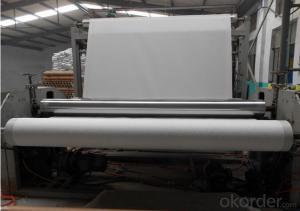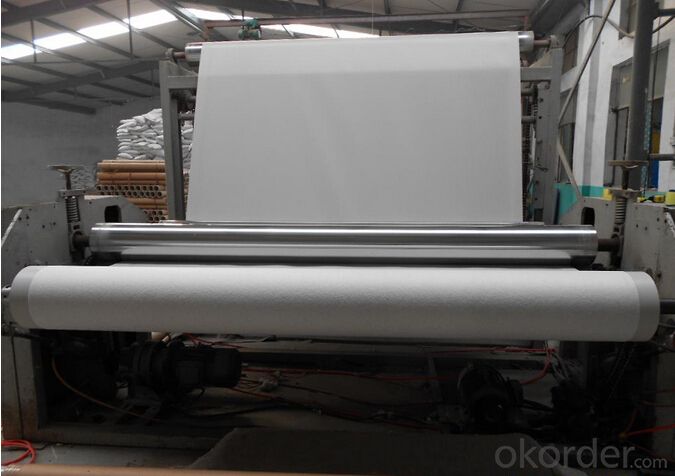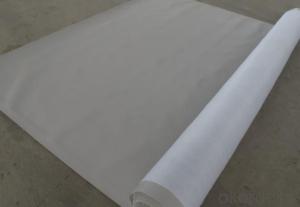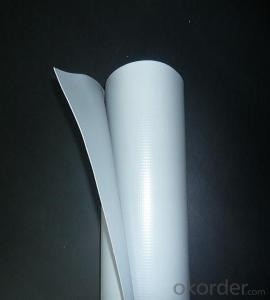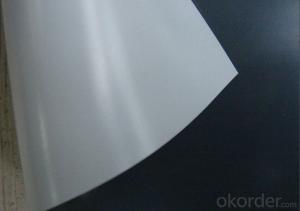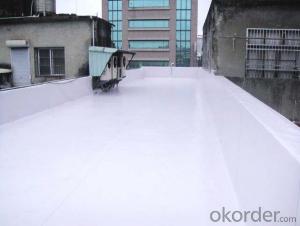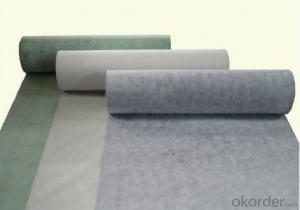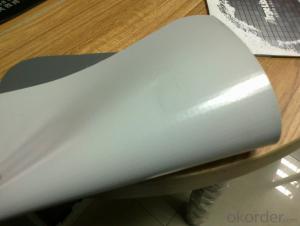Polyvinyl Chloride (PVC) Waterproof Membrane
- Loading Port:
- China main port
- Payment Terms:
- TT OR LC
- Min Order Qty:
- 5000 m²
- Supply Capability:
- 100000 m²/month
OKorder Service Pledge
OKorder Financial Service
You Might Also Like
1. Specification of PVC Waterproofing Membrane
Length | 20m/roll or customized |
Width | 2.05m |
Thickness | 1.2mm; 1.5mm; 2.0mm |
Type | Homogeneous, Reinforced, Fabric back |
If Exposed | Exposed and Non-exposed |
Color | White, Grey or customized |
2. Introduction of PVC Waterproofing Membrane
Polyvinyl Chloride (PVC) waterproof membrane is a new polymer waterproof membrane which is made from polyvinyl chloride resin, and mixed with plasticizer, filler, antioxygen, ultraviolet absorber and other auxiliaries.
3. Features of PVC Waterproofing Membrane
1) Excellent aging resistance. Service life of roofing material is over 20 years;
service life of underground material is over 50 years.
2) Root resistant penetration, specially used on planting roof.
3) Welding installation. Joints are solid and environment friendly, no pollution.
4) High tensile strength, good elongation and dimensional stability.
5) Good plasticity, easy and suitable for details installation.
6) Fireproof. Fire extinguished out of the ignition resource.
7) Surface is smooth, no fading and dirty resistant.
4. Types of PVC Waterproofing Membrane
N1—Exposed PVC waterproof membrane.
(It is mainly used as details treatment for exposed roof waterproof project)
N2—Non-exposed PVC waterproof membrane.
(It is mainly used as details treatment for non-exposed roof waterproof project)
L1—Exposed PVC waterproof membrane with fabric.
(It is mainly used for exposed roof waterproof project)
L2—Non-exposed PVC waterproof membrane with fabric.
(It is mainly used for non-exposed roof waterproof project)
W1—Exposed reinforced PVC waterproof membrane .
(It is mainly used for steel structure roof exposed waterproof project)
W2—Exposed reinforced PVC waterproof membrane .
(It is mainly used for steel structure roof non-exposed waterproof project)
5. FAQ of PVC Waterproofing Membrane
a.Can we get some samples before place order?
Answer: We can send the free samples to you by freight collect.
b.How many years can your PVC membrane guarantee?
Answer: We will guarantee the quality for 5 years at least.
c.Which countries you ever export the product?
Answer: We export the PVC membrane to South Africa, Middle east and even European countries.
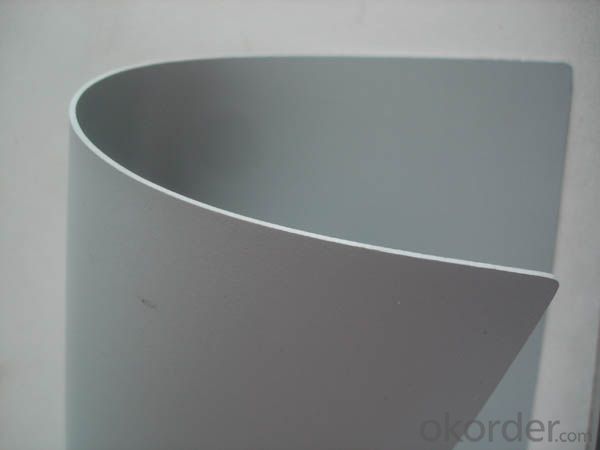
- Q: Are waterproofing membranes resistant to water vapor transmission?
- Waterproofing membranes possess a resistance to the transmission of water vapor. These membranes function to construct a barrier, effectively hindering water penetration. Typically composed of impermeable materials like rubber, plastic, or bitumen, they effectively obstruct the flow of liquid water, preventing its infiltration into the underlying structure. Nevertheless, it is worth noting that although waterproofing membranes can effectively resist the transmission of water vapor, it may not entirely eradicate it. A certain degree of water vapor may still manage to permeate the membrane, albeit significantly reduced in comparison to materials not specifically intended for waterproofing.
- Q: What are the common mistakes to avoid when installing a waterproofing membrane?
- To ensure the effectiveness and longevity of a waterproofing membrane, it is crucial to steer clear of certain common mistakes. These mistakes can include: 1. Insufficient surface preparation: One of the most prevalent errors is neglecting to adequately prepare the surface before membrane installation. This may involve not thoroughly cleaning the surface, leaving cracks or holes unfilled, or failing to remove loose debris. Inadequate surface preparation can compromise the membrane's adhesion and result in leaks. 2. Improper selection of membrane: Selecting the wrong type of waterproofing membrane can prove to be a costly blunder. Different membranes are designed for specific applications and environmental conditions. It is essential to choose a membrane that is suitable for the specific project requirements in order to ensure its effectiveness and durability. 3. Insufficient membrane overlap: Properly overlapping the membrane is crucial in creating a continuous barrier against water infiltration. Insufficient overlap can result in water seepage and jeopardize the integrity of the waterproofing system. It is important to adhere to the manufacturer's instructions regarding the recommended overlap width and ensure proper adhesion between the overlapped sections. 4. Incorrect membrane installation: Improper installation techniques can also lead to issues with the waterproofing membrane. This can include uneven application of the membrane or using incorrect installation tools. It is imperative to adhere to the manufacturer's guidelines and recommendations for installation to guarantee a proper and effective waterproofing system. 5. Neglecting proper drainage: Adequate drainage should always accompany waterproofing membranes. Failure to install proper drainage can lead to water pooling on the surface, which can cause membrane degradation and potential leaks. It is important to consider the slope and design of the drainage system to ensure efficient water removal. 6. Lack of regular inspection and maintenance: Once the waterproofing membrane is installed, regular inspections and maintenance are essential. Neglecting these can result in unnoticed issues such as damage or deterioration, which can compromise the waterproofing system. Regular inspections and timely repairs or maintenance can help extend the life of the membrane and prevent costly repairs in the future. By avoiding these common mistakes during the installation process and ensuring proper maintenance, you can enhance the effectiveness and longevity of your waterproofing membrane, providing reliable protection against water infiltration.
- Q: Can a waterproofing membrane be used on tunnels with railway systems?
- Tunnels with railway systems can indeed utilize waterproofing membranes. These membranes are widely employed in tunnel construction to prevent water ingress and safeguard the tunnel structure against deterioration. By effectively sealing the tunnel walls, ceilings, and floors, they successfully prevent water from seeping into the tunnel, thereby averting potential damage to the railway system or infrastructure. Specifically designed to withstand the high-pressure conditions and constant vibrations associated with railway operations, these membranes are typically composed of durable materials like PVC, HDPE, or modified bitumen. Such materials not only offer excellent waterproofing properties but also ensure long-term durability. Moreover, these membranes can be effortlessly installed during the tunnel's construction phase or retrofitted onto existing tunnels, causing minimal disruption to railway operations. In essence, the utilization of waterproofing membranes has proven to be a reliable and efficient technique for ensuring the structural integrity and longevity of tunnels with railway systems.
- Q: Can a waterproofing membrane be used for a hospital?
- Yes, a waterproofing membrane can be used for a hospital. Waterproofing membranes are commonly used in hospitals to prevent water infiltration and protect the building from water-related damages. They are especially useful in areas with high moisture levels such as bathrooms, basements, and roofs. By installing a waterproofing membrane, hospitals can ensure a dry and safe environment for both patients and staff, reducing the risk of mold, mildew, and structural deterioration caused by water damage.
- Q: Can a waterproofing membrane be used for underground parking structures?
- Yes, a waterproofing membrane can be used for underground parking structures. Underground parking structures are particularly vulnerable to water infiltration due to their location and exposure to groundwater. Waterproofing membranes are designed to provide a protective barrier against water penetration, preventing potential damage to the structure and its contents. These membranes are typically applied to the exterior walls and floors of the underground parking structure, ensuring a watertight seal. Additionally, the use of a waterproofing membrane can also help to prevent the formation of moisture-related issues such as mold growth, corrosion, and deterioration of concrete. Therefore, incorporating a waterproofing membrane is essential for the long-term durability and functionality of underground parking structures.
- Q: Can a waterproofing membrane be used for a garden pond?
- Yes, a waterproofing membrane can be used for a garden pond. Waterproofing membranes are designed to create a barrier against water leakage, making them suitable for lining and sealing garden ponds to prevent water from seeping into the surrounding soil.
- Q: Can a waterproofing membrane be used for bridge decks?
- Yes, a waterproofing membrane can be used for bridge decks. Bridge decks are exposed to various weather conditions, including rain, snow, and humidity, which can cause damage and deterioration over time. Therefore, applying a waterproofing membrane on the bridge deck surface can help protect it from water infiltration and moisture-related issues such as corrosion of steel reinforcements. Waterproofing membranes are specifically designed to create a barrier that prevents water from penetrating the surface. They are typically made from materials such as modified bitumen, thermoplastic, or liquid-applied coatings. These membranes are applied to the bridge deck surface, creating a seamless and watertight layer that prevents water from seeping into the deck structure. In addition to preventing water infiltration, waterproofing membranes can also provide additional benefits for bridge decks. They can help reduce the risk of freeze-thaw damage, protect against chemical attacks from de-icing salts or pollutants, and increase the overall durability and lifespan of the bridge deck. It is important to note that the selection of the appropriate waterproofing membrane for a bridge deck depends on various factors such as the type of bridge, traffic conditions, climate, and expected service life. Therefore, it is essential to consult with structural engineers and waterproofing specialists to choose the most suitable membrane system for a specific bridge deck project.
- Q: Can a waterproofing membrane be used on tunnels with railway systems?
- Yes, a waterproofing membrane can be used on tunnels with railway systems. The membrane helps to prevent water ingress and moisture damage to the tunnel structure, ensuring the safety and longevity of the railway system.
- Q: Can waterproofing membranes be used on roofs?
- Yes, waterproofing membranes can be used on roofs. Waterproofing membranes are specially designed materials that are used to provide a protective layer on roofs to prevent water penetration. These membranes are typically made of materials such as modified bitumen, EPDM, PVC, or TPO, which are highly resistant to water and can effectively seal the roof. They are commonly used in both residential and commercial applications, including flat roofs, low-slope roofs, and even sloped roofs with certain designs. Waterproofing membranes are applied in multiple layers to ensure maximum protection against water damage and can greatly extend the lifespan of a roof by preventing leaks and moisture buildup.
- Q: Are there any limitations to using a waterproofing membrane?
- Yes, there are some limitations to using a waterproofing membrane. One limitation is that the membrane can be punctured or damaged during installation, which can compromise its effectiveness. Additionally, waterproofing membranes may not be suitable for all types of surfaces or structures, and certain conditions such as extreme temperatures or excessive movement can affect their performance. Moreover, the lifespan of a waterproofing membrane can vary depending on factors like maintenance, exposure to UV rays, and overall wear and tear.
Send your message to us
Polyvinyl Chloride (PVC) Waterproof Membrane
- Loading Port:
- China main port
- Payment Terms:
- TT OR LC
- Min Order Qty:
- 5000 m²
- Supply Capability:
- 100000 m²/month
OKorder Service Pledge
OKorder Financial Service
Similar products
Hot products
Hot Searches
Related keywords
